Don’t call it a comeback.
Just a generation ago, our entire planet was pretty much Gose-free. Today, however, the craft beer world has fully embraced Gose, the once-extinct, sour-salty beer style from Germany.
Sites like Ratebeer.com list thousands of commercially brewed versions, with more added every week. It has become a go-to recipe for homebrewers around the globe. Are other obscure German beer styles ready to take a similar star turn?
That’s the question posed by Andreas Krennmair, homebrewing hobbyist and author of a new book, “Historic German and Austrian Beers for the Home Brewer.” Published in February, the book includes recipes for 22 arcane types of Old World beers. It’s the first English-language volume to include full details for weirdo styles like Merseburger, which even Randy Mosher’s revered 2004 style guide, “Radical Brewing,” listed as little more than a name without including a recipe.
“It’s very dark, it’s extremely bitter — that’s something that is rather well-documented,” Krennmair says of his circa-1826 recipe for Merseburger. It includes gentian root and and bitter orange peel, two ingredients commonly used in cocktail bitters.
Though his book has only been out for a couple of weeks, its recipes have already started attracting attention from both professional and amateur brewers. Homebrewers have reached out to Krennmair with feedback after brewing his 1818-era Bamberger Lagerbier. London microbrewery The Owl & The Pussycat is currently serving its own Merseburger from Krennmair’s recipe, which he calculates at a tongue-numbing 125 IBUs.
“There’s a quote from Goethe about Merseburger that says that when you start drink it, it’s way too bitter, but after a week you get used to it,” he says. “It really used a crazy high amount of hops.”
The book came out of Krennmair’s homebrewing hobby, which led him to investigate and collect historical styles. Originally from Austria, Krennmair now lives in Berlin, where he was able to do additional research using the archives of the German capital’s renowned Institute for Fermentation and Biotechnology, commonly known as the VLB.
The obscure top-fermenting styles like Merseburger, Broyhan, and Berliner Braunbier will probably earn the most interest from brewers. But the book also includes details on unknown bottom-fermented beers from Bavaria and Franconia, including Bamberger Lagerbier, Salvatorbier, and Augsburger Lagerbier.
“I think a lot of the details around the Bavarian beers — in particular with mashing and how different that used to be — will be surprising for many,” Krennmair says. “Augsburger Lager has a really weird way of mashing. The German term for it is Satz brauen. It starts with mashing in cold, then you draw off a little bit of the wort, then the main mash is being heated up by adding boiling liquor, and more wort is removed and mixed with the cold wort from earlier, and after a rest of a few hours it is mixed back in again.”
Complicated mashing processes and oddball ingredients like bitter orange peel and molasses (in Krennmair’s 1831-era Fredersdorfer Bier) might sound strange to anyone who still thinks of German beer in terms of the Reinheitsgebot, the brewing purity law from 1516. This decree generally forbids ingredients beyond water, malt, hops, and yeast.
But Krennmair notes that even in the 16th and 17th centuries, exceptions to the Reinheitsgebot were regularly made for ingredients like bay leaves, coriander, salt, juniper, and caraway seeds.
Although Krennmair was able to put together recipes for just under two dozen under-recognized styles, there is still a lot more left to rediscover.
“There are, I would say, about 100 local beer styles, of which I couldn’t find more than a name,” he says, running off a list of styles — Gustrauer Ginseneck, Kieler Wittwe, Magdeburger Filz, and Hallescher Puff — that sound like they might have been lifted from Jabberwocky.
“There is so much more that is not properly fully documented yet,” he says
While The Owl & The Pussycat has taken the lead in the unofficial Merseburger arms race, Gustrauer Ginseneck is notably absent from a search of brewery databases. It appears no brewers anywhere in the world are releasing commercial versions of this still-obscure German beer.
At least not yet.
